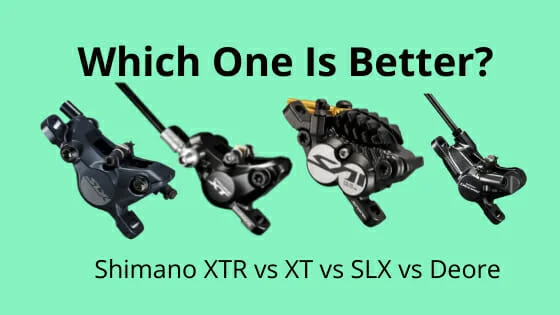The Shimano drivetrain is, without a doubt, the most popular out there, and for a good reason. They offer many options to suit your riding style, power output, budget, and bike weight. But how do you go about choosing the best drivetrain option for you?
In this article, we’ll compare the Shimano XTR vs XT vs SLX vs Deore counterparts. Also, we’ll discuss various drivetrain features that you should consider in your decision-making.
Shimano XTR vs XT vs SLX vs Deore: Comparison Chart
The XTR, XT, SLX, and Deore are all mountain bike groupsets offered by Shimano. They’re all similar in that they offer similar performance levels and features, but some important differences set them apart.
| Characteristics | XTR | XT | SLX | Deore |
| Groupsets | 1557g | 1804g | 1879g | 2108g |
| Crankset | 170mm or 175mm | 165mm, 170mm or 175mm | 165mm, 170mm or 175mm | 170 or 175mm |
| Crankset configuration | Two-piece | One-piece | Two-piece | Two-piece |
| Tooth | 32 | 30 | 34 | 32 |
| Chain | 269g | 278g | 279g | 277g |
Shimano XTR vs XT vs SLX vs Deore: Key Difference
The main difference between these groupsets is the materials used and the weight. XTR uses the best materials and is the lightest weight, while Deore uses lower-quality materials and is the heaviest.
Cranks
On the Dior level, you can expect a 170-175-millimeter crank. They’ve just announced a 165. So great for shorter riders. So your cranks having that clearance is essential. You can expect those to weigh 780 g.
But moving up to SLX now, you get 165, you get the 170, you get the 175 options in these, and the weight is less than 638 g. X. T. has 165 and 175 options. So, if you’re lofty, the 180 could be for you.
XDR 165 175 options, 573 g this time with the 32. I’ve got options from 30 up to 38, which tells you who it’s aimed at: the real cross country or the marathon enthusiasts there.
Chains
The cool thing about this 12-speed stuff is it’s all hyperglide plus. SLX has the same hyperglide plus, but it has plates with gray links.
But XT chromizing treatment on the plate and links. This is the most durable treatment you can get on them again.
The exact weight is 252 g, and the price is 40 quid. So, it is slightly up. But the critical feature is durability and strength when it comes to X. T. Finally, the XDR visually looks quite different.
So it’s designed to have minimal friction, saving as much as five watts to a rider, which probably doesn’t make that much difference to me.
XT is the best for durability and performance, whereas SLX puts a little more function on keeping pricing down but giving you performance shifting.
Cassette
When you look at the cassettes themselves, you can see their differences. SLX has one aluminum sprocket and 11 steel sprockets on its 1045 and 1051 options.
So you can run it with a two by 1045, or the one by 1051 weighs less than 534 g and costs more than 115 quid. XT visually has two alloy sprockets at the top and ten steel sprockets for durability.
XTR weighs 367 g in the one-by-12 star setup, you can get 1045 as well, but it does cost 325 quid.
Shifters
The Deore shifters visually look very similar. So, deal one has a maximum of three shifts at a time.
It has a two-way release on the shifter itself in both directions. And it’s got a nice spec clamp or clamp-on options.
The regular clamp is four g additional, and you’re talking about 37 quid SLX one, a maximum of three shifts has a two-way release and an instant release. So, quicker downshift that into the higher gears 133 g that weighs and costs 41 quid.
XT is probably where I’d go to look at one of my bars there. It’s got to weigh release instant and a multi-way release. So you can shift two gears in one stroke.
Just got a bit more grip there, 135 g, so barely any difference in weight, and it costs 60 quid, and then you got the X. T. R.
Weight
Shimano XTR tends to be the lightest, followed by XT, SLX, and Deore. When it comes to biking components, weight matters. Lighter parts mean less strain on your body, especially during long rides or uphill climbs. Here’s a breakdown of the weight differences between Shimano’s popular mountain biking groupsets: XTR, XT, SLX, and Deore.
1. Shimano XTR: Known for its top-tier performance and precision engineering, Shimano XTR groupsets are designed with weight optimization in mind. XTR components are crafted using advanced materials like carbon fiber and titanium, resulting in the lightest weight among Shimano’s offerings.
2. Shimano XT: Positioned just below the XTR series, Shimano XT balances performance and affordability. While XT components may not be as featherweight as XTR, they still prioritize weight reduction through strategic material selection and engineering. Expect XT components to be slightly heavier than XTR but still lighter than SLX and Deore.
3. Shimano SLX: SLX groupsets aim for riders seeking reliable performance without breaking the bank. While SLX components offer impressive durability and functionality, they tend to be slightly heavier than XTR and XT. However, the weight difference between SLX and XT is generally minimal and may not be noticeable for many riders.
4. Shimano Deore: Positioned as Shimano’s entry-level mountain biking groupset, Deore offers solid performance at an affordable price point. To maintain cost-effectiveness, Deore components may utilize slightly heavier materials than higher-end groupsets like XTR, XT, and SLX. As a result, Deore components are typically the heaviest among the four mentioned here.
Brakes
Shimano XTR brakes offer the highest performance, followed by XT, SLX, and Deore. Brakes are essential for safe riding. Here’s how the braking systems of Shimano’s XTR, XT, SLX, and Deore compare:
1. Shimano XTR: Known for top-notch performance, XTR brakes use advanced materials and design for exceptional stopping power and control. They’re ideal for demanding trails and competitive riding.
2. Shimano XT: XT brakes provide excellent performance at a more affordable price point. They offer reliable braking power and durability, suitable for most riding conditions.
3. Shimano SLX: SLX brakes focus on affordability and reliability while still delivering solid braking performance for trail riding.
4. Shimano Deore: Deore brakes are the entry-level option, offering basic braking performance at a budget-friendly price. They’re suitable for recreational riding and entry-level trails.
Speed
The number of speeds a bike offers affects its versatility and performance. Here’s how the speed options of Shimano’s XTR, XT, SLX, and Deore groupsets compare:
1. Shimano XTR: Known for high performance, XTR groupsets often offer the most speed options. With a wide range of gears, XTR enables precise gear selection for various terrains and riding styles.
2. Shimano XT: XT groupsets come with a slightly reduced number of speeds compared to XTR but still provide ample gearing options for most riders. XT offers a good balance between performance and affordability.
3. Shimano SLX: SLX groupsets typically offer fewer speeds than XT and XTR but still provide enough gearing range for most trail riding situations. SLX is known for its reliability and durability at a more budget-friendly price.
4. Shimano Deore: Positioned as the entry-level option, Deore groupsets may have the fewest speeds among the four. However, they still offer sufficient gearing options for beginners and casual riders, ensuring smooth riding on various terrains.
MTB Rear Mech Comparison
The Deore shifters visually look very similar. So, deal one has a maximum of three shifts at a time. It has a two-way release on the shifter itself in both directions. And it’s got a nice spec clamp or clamp-on options.
The regular clamp is four g additional, and you’re talking about 37 quid SLX one, a maximum of three shifts has a two-way release and an instant release. So, quicker downshift that into the higher gears 133 g that weighs and costs 41 quid.
XT is probably where we’d go to look at one of our bars there. It’s got to weigh release instant and a multi-way release. So you can shift two gears in one stroke.
Just got a bit more grip there, 135 g, so barely any difference in weight, and it costs 60 quid, and then you got the X. T. R.
What Is The Best Gear Ratio For Climbing Hills?
The gear ratio is the number of teeth on a cog about the size of its pulley. The lower the gear ratio, the easier it’s for you to progress up steep inclines; however, this comes at the cost of making your bike harder to pedal uphill and climbing steeper grades.
50/34, 36/40, 34/32, and 32/20 are all good ratios to start with and will be good starting points for the rest of your mountain biking career.
In addition to not sinking into rocks in the bike’s pedal stroke, with the right ratio, you can keep your weight more centered over the rear wheel.
What Is The Best Chainring For Climbing?
Regarding which chainring to use, it depends on how often you’re climbing and how steep the climbs are.
A 32-tooth chainring (the smallest possible) is great for climbing steeper grades, but if you’re primarily riding slower paced trails or spending more time in the saddle, a 20-tooth chainring is probably better.
In general, mountain bikers tend to use different chainrings for different trails.
For example, if you’re riding faster on a trail, you’ll want to use a 26- or even a 28-tooth chainring. If the trail is slightly steeper than your riding speed, maybe around 4-5%, you may want to use a 32 or 34-tooth chainring.
FAQs For Deferent Shimano XTR vs XT vs SLX vs Deore
Is XTR better than Deore?
Shimano XTR is a good choice for a more inexpensive and lighter-weight drivetrain. Deore is often more durable and perfect for heavier riders. Deore is great for those who are very hard on their drivetrains and are looking for durability to ensure they get the most out of it.
What is the difference between Shimano XT and XTR?
The main difference is that XT has a 1x ring and cassette, while XTR has a 2x ring and cassette. The XT only comes in a triple chainring set-up. These differences are designed to improve the drivetrain’s performance as riding conditions vary by the rider.
What do Shimano’s model numbers mean?
Shimano’s model numbers indicate the order in which the company’s products were released. For example, the first model number released was the Dura-Ace, followed by the Ultegra and then the 105. The higher the number, the newer the product.
Is Shimano SLX or XT better?
XT is generally considered better than SLX due to its higher performance, more advanced features, and lighter weight, but SLX provides excellent performance at a more affordable price point.
What is the difference between Shimano SLX and Deore?
What is Shimano XT equivalent to?
Shimano XT is equivalent to SRAM GX Eagle in terms of performance and price point.
What is Shimano SLX for?
Shimano SLX is a mid-range mountain biking groupset designed for trail riding and enduro racing, offering a balance of performance, durability, and affordability.
Conclusion
So, from the Shimano XTR vs XT vs SLX vs Deore comparison, we can say the XTR is the best for those who want the best performance. The XT is a good choice for those who want good performance but don’t want to spend as much as the XTR.
The SLX or Deore are good choices for those who want decent performance but don’t want to spend much money.

I am Ryan Ford, a mountain biking enthusiast who loves to explore the outdoors. I also like to go on adventures with friends and anything else that involves being outside. I love my bike because it gets me out of the house and gives me an opportunity to enjoy nature.


